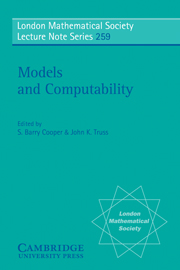Book contents
- Frontmatter
- Contents
- Preface
- Continuous Functionals of Dependent and Transfinite Types
- Degree-Theoretic Aspects of Computably Enumerable Reals
- Simplicity and Independence for Pseudo-Algebraically Closed Fields
- Clockwork or Turing U/universe? - Remarks on Causal Determinism and Computability
- A Techniques Oriented Survey of Bounded Queries
- Relative Categoricity in Abelian Groups
- Computability and Complexity Revisited
- Effective Model Theory: The Number of Models and Their Complexity
- A Survey on Canonical Bases in Simple Theories
- True Approximations and Models of Arithmetic
- On the Topological Stability Conjecture
- A Mahlo-Universe of Effective Domains with Totality
- Logic and Decision Making
- The Sheaf of Locally Definable Scalars over a Ring
- Human Styles of Quantificational Reasoning
- Recursion Theoretic Memories 1954–1978
- Fields Definable in Simple Groups
- A Combinatory Algebra for Sequential Functionals of Finite Type
- Model Theory of Analytic and Smooth Functions
Relative Categoricity in Abelian Groups
Published online by Cambridge University Press: 17 May 2010
- Frontmatter
- Contents
- Preface
- Continuous Functionals of Dependent and Transfinite Types
- Degree-Theoretic Aspects of Computably Enumerable Reals
- Simplicity and Independence for Pseudo-Algebraically Closed Fields
- Clockwork or Turing U/universe? - Remarks on Causal Determinism and Computability
- A Techniques Oriented Survey of Bounded Queries
- Relative Categoricity in Abelian Groups
- Computability and Complexity Revisited
- Effective Model Theory: The Number of Models and Their Complexity
- A Survey on Canonical Bases in Simple Theories
- True Approximations and Models of Arithmetic
- On the Topological Stability Conjecture
- A Mahlo-Universe of Effective Domains with Totality
- Logic and Decision Making
- The Sheaf of Locally Definable Scalars over a Ring
- Human Styles of Quantificational Reasoning
- Recursion Theoretic Memories 1954–1978
- Fields Definable in Simple Groups
- A Combinatory Algebra for Sequential Functionals of Finite Type
- Model Theory of Analytic and Smooth Functions
Summary
Abstract
We consider structures A consisting of an abelian group with a subgroup AP distinguished by a 1-ary relation symbol P, and complete theories T of such structures. Such a theory T is (κ, λ)-categorical if whenever A, B are models of T of cardinality λ with AP=BP and |AP|=κ, there is an isomorphism from A to B which is the identity on AP. We state all true theorems of the form: If T is (κ, λ)-categorical then T is (κ′, λ′)-categorical.
Introduction
Relative categoricity has been for a long time one of the least popular branches of stability theory. In 1986 Saharon Shelah published a formidable paper giving a deep classification under a weak form of the generalised continuum hypothesis, and concluding ‘There are no particular problems (especially if you have read §4)’. I am not sure whether his paper contains any results that one could explain to a non-specialist. Since Shelah's paper there has been nothing like the Paris breakthrough that suddenly made classical stability theory all the rage in 1979. To the best of my knowledge nobody has made a serious attempt at a geometric theory outside the context of covers. Let me add a morsel of temptation: relative categoricity was probably the first area where first-order stability methods were applied to unstable theories.
- Type
- Chapter
- Information
- Models and Computability , pp. 157 - 168Publisher: Cambridge University PressPrint publication year: 1999

